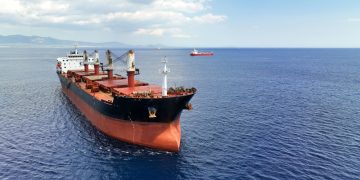During the 2023 SAFETY4SEA Singapore Forum, Capt. Hari Subramaniam, Regional Head – Business Relations of The Shipowners’ Club, reminded us that the clock is ticking as the industry continues to hurtle towards 2030 where the first waypoint of the IMO GHG strategy will be reached.
Key items:
- Decarbonisation – Where are we headed?
- Challenges for Smaller Operators and Industry Initiatives
- Claims Experience Vs Risk Change Perception
- 20% of the world’s fleet over 100 GT (UNCTAD 2022) insured by The Shipowners’ Club

When the 2018 IMO GHG Strategy was initially released, although a lot of changes were required to be made, it was still deemed to be within reach. However, we were already in 2023 and with only 7 years remaining for the first target, it was apparent that the industry was lagging in the race. The previous target was 70% reduction in carbon footprint by 2050 however to increase the tempo, the new IMO targets released in 2023 required 70% reduction in carbon footprint by 2040 and introduction of an extra element of having to reduce GHG components by 70 to 80%. The shipping industry is to achieve Net-Zero by 2050. This has been a wake-up call for all the industry players and all efforts must be increased exponentially.

In Singapore, from 2030, all new harbour crafts should be fully electric or be capable of using B100 biofuels or be compatible with net-zero fuels such as hydrogen or ammonia. At the same time, there is ensuing support from the industry partners on voyage optimization, virtual arrival (VA) and Just In Time (JIT). Member states are also bringing in special green notations for vessels to encourage and support the decarbonization drive. Various projects are underway between IMO and Member states/industry partners.
Addressing climate change
The flow chart below gives us a good overview on the journey ahead with the check points on 2030, 2040 and 2050.

Challenges for Smaller Operators
- Higher capital (building) costs – can go up to nearly 200-300% per vessel.
- Heavier displacement – lesser cargo/passenger carrying capacity will pose a problem.
- Sophisticated vessels in comparison to current conventional boats.
- Uncertainty regarding design, technology, endurance, maintenance, spares.
- Questions regarding uninterrupted availability of alternate/green fuels.
- In the case of electrification, safety concerns regarding fires, lead/acid pollution etc.
- Human capital, training, and expertise.
- May not be a financially viable venture for smaller operators.
- Possible increase in H&M premiums.
Different Green Solution Strategies
Among the different alternative fuels, one the most popular lower carbon fuels is LNG. Whilst there are many advantages over conventional fossil fuels, there also lies a problem of methane slips wherein unburned methane escapes to the atmosphere in between the well to wake process. Methane is also actually about 80% more global warning effects than normal carbon dioxide, so there is a problem with that LNG. Methanol is another option and whilst it has its own challenges, the methane slip problem is eradicated.
Hydrogen powered cells are also an upcoming technology. The is still in the testing stages but again because of its properties may be only suitable for smaller ships on short voyages.
Electrification is viewed as another clean solution but there are also other issues to contend with such as batteries design and surrounding fire hazards, storage and the most important factor is that the electricity must be derived from renewable energy. We can’t burn trees and other natural resources to generate electricity to power our boats – it simply defeats the purpose.
We also have different new evolving sources of renewable energy derived from the likes of wind and waves. They are all in different stages of evolution. Nuclear technology is another potential solution where, if controlled, it can probably be rolled out very measuredly. Ammonia too has got its own bag of challenges with toxicity problems and health and safety concerns.
Claims Experience Vs Risk Change Perception:
As such, from a risk perspective, the potential claims arising from these newer technologies and handling of alternative fuels may be significant from a number and impact perspective. The main heads of claims and the rick change perception are listed below:
- Crew illness/injury/death – Probable increase with new technologies?
- Cargo loss/damage – Probable increase with new technologies with increased fire hazards?
- Environment – pollution and wreck – Possibly some change in pollution, also probable increase in the wreck removals associated with electrical/methanol fire etc.
- Navigation – No perceived change in risk however loss of power leading to collisions/groundings could be significant in the initial periods of implementation.
- Passenger – No perceived change in risk
In conclusion, all stakeholders will eventually have to come together and adopt a range of solutions as it seems apparent that with the varied spectrum in shipping, one size will not fit all. The MPA has come out with their various expressions of interest (EOI). Furthermore, Administrations such as Singapore are actively engaging with all the stakeholders/service providers to come together and offer support and keep the industry sustainable. Decarbonization is not any single stakeholder’s problem – it is a collective problem of every person living on the planet.
Above article has been edited from Capt. Hari’s Subramaniam presentation during the 2023 Singapore Forum.
Explore more by watching his video presentation here below.
The views presented are only those of the author and do not necessarily reflect those of SAFETY4SEA and are for information sharing and discussion purposes only.


































































